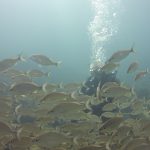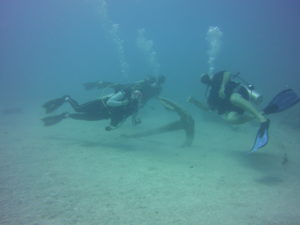The Benwood wreck Key Largo

The Benwood wreck Key Largo is a very popular dive site. The Benwood sank in April 1942 after a collision with the Robert C Tuttle. Both ships were running ‘blacked out’ at night to avoid being spotted by enemy U-boats. Unfortunately the Benwood came off worse after hitting the Robert C. Tuttle. The Benwood captain tried to back up onto the reef in an attempt to save the vessel and its cargo but she slipped off and sank in 25 – 45 feet of water. After sinking she was also used for target practice by the air force and the damage to her decks is apparent. In later years the coastguard also ran a cable over the top of the deck as it had become a hazard to shipping.
The Robert C Tuttle was subsequently hit by a torpedo from a Uboat that June and sank.
Todays Benwood
Today the Benwood is a spectacular dive for open water and advanced divers with the stern facing shoreward in 25 feet of water and her broken bow facing out to sea in 45 feet of water. If divers want to get more depth there is a ridge off her bow, locally known as ‘the elevator’ that goes down to 80 feet.
This wreck is covered bow to stern in large schools of fish. Our suggestion to our divers who are taking photographs is to stay still and let the fish come to you and you will be surrounded in no time particularly at the stern.
The wreck is around 310 feet long and 50 feet wide and is broken up and scattered at the stern. Overall the ship has nothing much above the deck. The boy has large concentrations of fish life. The stern has many interesting knooks and crannies to look in and under. On your way around the wreck be sure to look under the hull of the boat where it meets the snad and tou with often find scorpion fish hiding there in their disguise.

Prior to hurricane Irma in 2017 the dive on the Benwood often had poor visibility but in the months after Irma passed we notice how much the visibility had improved and it maintains its better visibility to this day (2024)During Hurricane Irma the wreck also suffered further damage to the Bow and uncovered an anchor that lies off the bow. We do not believe this anchor belongs to the Benwood.
Dive Schedule
We dive the Benwood a couple of times a week along with other Key Largo wrecks. Prices are listed here. If you would like to dive this wreck make sure you let us know whilst making your reservation or email us to see when the next scheduled dive is for the Benwood.
Dive Plan
The mooring balls are all off to the side of the wreck. During the dive brief we will advise where on the wreck we are moored. As always our suggestion is to swim toward the front of the boat and follow the mooring line adjusting your buoyancy as you reach the bottom. Take note of where you are located in relation to the wreck and take note of any particular features of the wreck that will help you identify where you need to leave the wreck to get back to the mooring line. Its personal preference which way round the wreck you go and where the mooring line is. You can navigate around in 30 minutes.
We love the front of the wreck. If you approach slowly keeping close to the deck you will end up in the school of grunts, as you get to where the supersructure rises you can slowy ascend and then look dow over the front of the wreck for a great view of the fish schooling either side of the bow. Like wise if you start a the bottom of the bow and slowly work you way up the bow is covered with wildlfe and in you may see a Flaming Tongue snail.
Despite having all of the qualifications for an invasive species, the flamingo tongue snail never kills their hosts and lives amicably, leaving only a small trail of dots upon the coral as it feeds. Inside the brilliantly patterned soft-tissue shell is a bright-colored animal with tentacles, two sensory organs on its head that resemble horns, eyes on top of these “horns,” and a foot that it uses to eat. This foot is called a radula and is more similar to a tongue as the flamingo tongue snail uses it to secrete chemicals that dissolve the coral into digestible food.
The slow-motion movement of the mollusk allows the coral enough time to regenerate, and the symbiotic relationship of these two species is furthered by co-protection. As the snail feeds, it takes in the toxins from the coral and is assimilated into the live mantel tissue of the shell. Predators of the flamingo tongue snail find this toxin distasteful and end up leaving both the mollusk and coral alone.
Moving on along side of the hull of the Benwood you should point your flashlight where the hull meets the sand where you will often see Scorpion fish hiding and there will definitely be some Squirrel fish hiding under there too!
